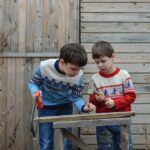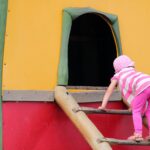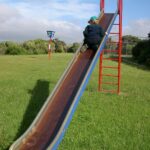Child level
Let’s go out: No more excuses to stay indoors!
All seasons are appropriate for children to spend time outside. However, spring, usually characterized by friendly weather (not too cold and not too hot), as well as interesting changes in the environment (growing and blooming plants), and the fact that it follows the short winter days, seems to be perfect to provide children with unique opportunities for outdoor exploration. Especially this year, as, due to the pandemic, many of them have spent more time indoors than usual.
Is “just being outdoors” valuable for children?
Outdoor time is still considered by some ECEC professionals and parents to be of less value for children’s cognitive development than time spent in a classroom. For some it is a kind of a break from learning-oriented activities that are taking place indoors. For others, the outdoor context is considered difficult to provide cognitively stimulating activities on a regular basis, and “just being outside” is considered insufficient in this respect. One might say that the general notion behind these assumptions is that some adults underestimate children’s potential to create cognitively valuable experiences on their own. This assumption seems to be unjustified though.
Math learning while playing outdoors
The case study conducted by Shiree Lee [1] provides evidence that even the youngest children, under the age of three, while being outdoors are capable of initiating activities that enhance development of their mathematical competences. Importantly it concerned behaviour of children whose play was not interrupted by adults by any means. Based on the analysis of nearly fifty hours of video recordings of children’s outdoor play, Lee identified seven mathematical categories: space, number, measurement, shape, pattern, classification, and problem solving. The first three occurred most often in children’s behaviour, whereas the three following ones were less evident. Findings suggest that outdoor play (lacking any adult’s stimulation) is a context with potential for math learning.
Outdoor spaces as the best context for risky play
ECEC professionals do not need to get involved in children’s play all the time to make it valuable. Nevertheless, by organizing the space they may enhance their developmental experiences. For example, more than a classroom context, the outdoor environment provides great opportunities for organizing spaces that encourage children to engage in risky play. Risky play is particularly important for their development. It allows children to challenge themselves by taking calculated risks and by doing so expand skills and build attitudes such as dealing with stress, dealing with failure, build self-confidence or perseverance.
Sandseter proposed following categories of risky play [2]:
- Rough-and-tumble play, e.g. tag of war
- Play near dangerous elements, e.g. play near a burning fire pit
- Play with dangerous tools, e.g. nail and hammer for carpentry
- Play with heights, e.g. climbing towers
- Play where the children can disappear/get lost
- Play with speed, e.g. sliding down from a slide
Additionally, providing children with opportunities for risky play may enhance their sense of belonging to the ECEC setting through their shared engagement in risky-play experiences [3].
To sum up, it is unquestionable that children benefit from spending time outdoors, also without adults involvement and getting involved in risky play.
We encourage you to reflect on the organization of the outdoor context in your setting
- To what extent do you engage in children outdoor activities?
- Does the organization of the outdoor space encourage children’s risky play?
This blog post was contributed by Olga Wysłowska (University of Warsaw).
References:
[1] Lee, S. (2012). Toddlers as mathematicians?. Australasian Journal of Early Childhood, 37(1), 30-37. [2] Sandseter, EBH. (2007). Categorising risky play – how can we identify risk-taking in children’s play? European Early Childhood Education Research Journal 15(2): 237–252. [3] Little, H., & Stapleton, M. (2021). Exploring toddlers’ rituals of ‘belonging’ through risky play in the outdoor environment. Contemporary Issues in Early Childhood, 1463949120987656.You must be logged in to post a comment.






